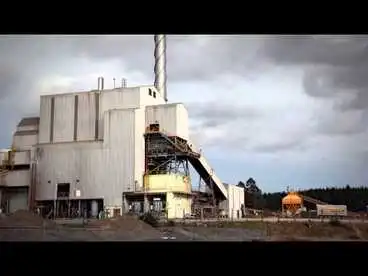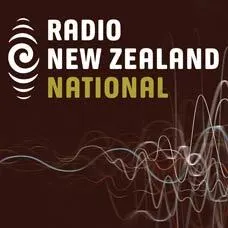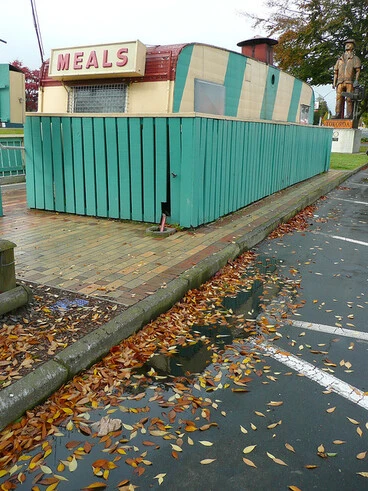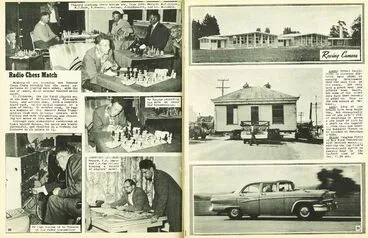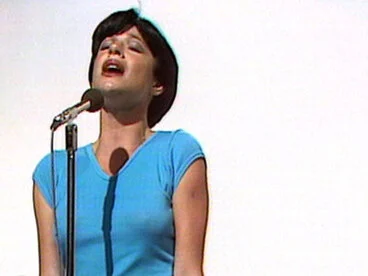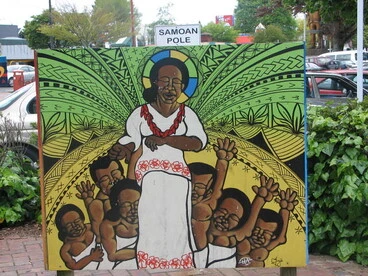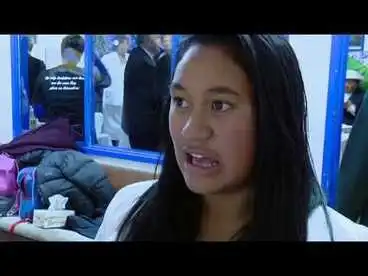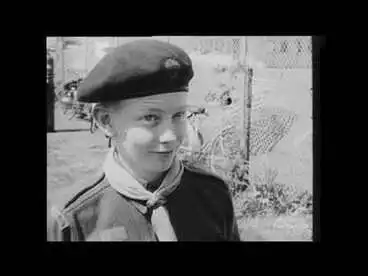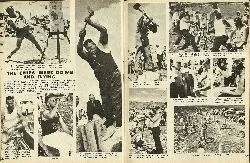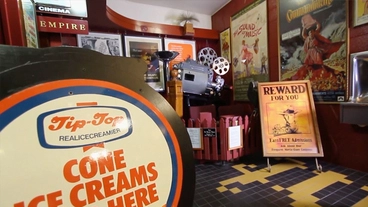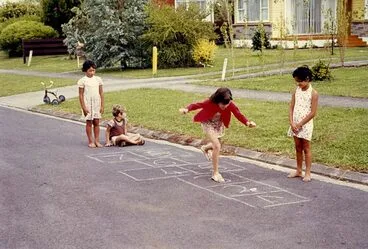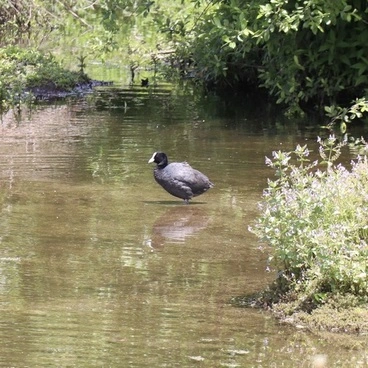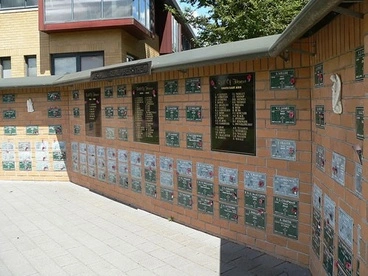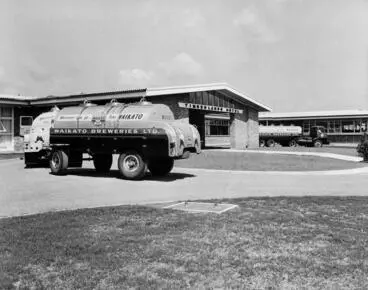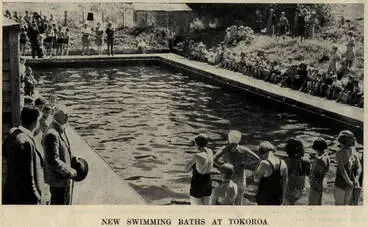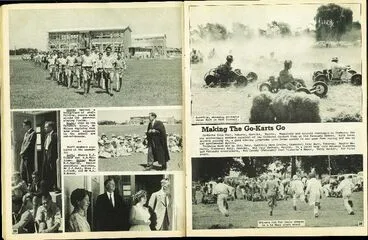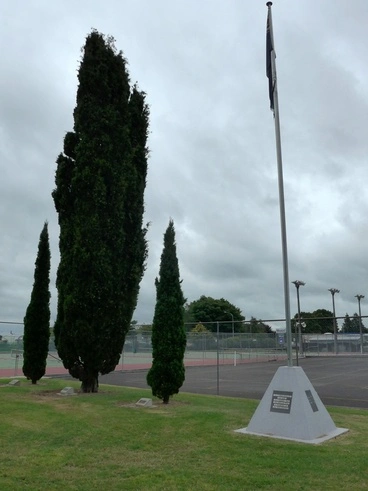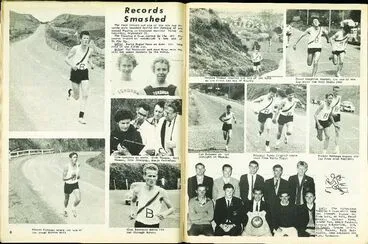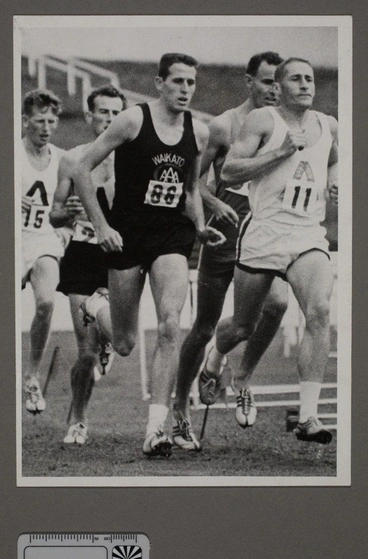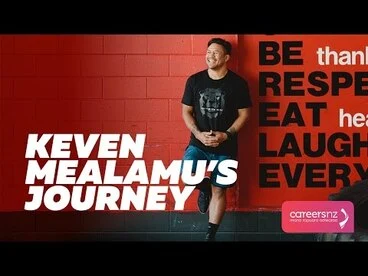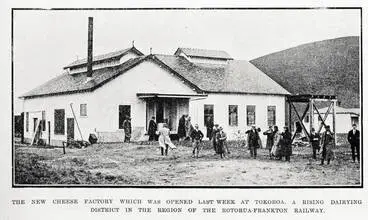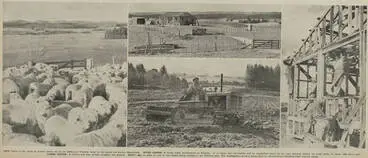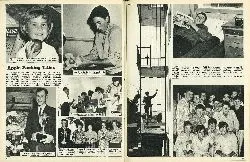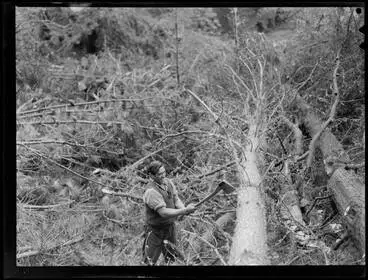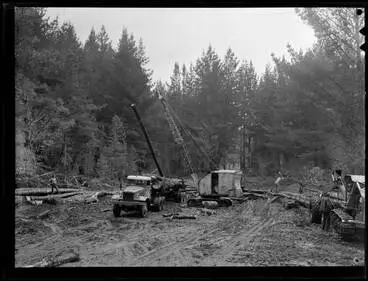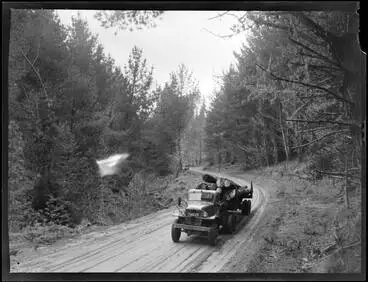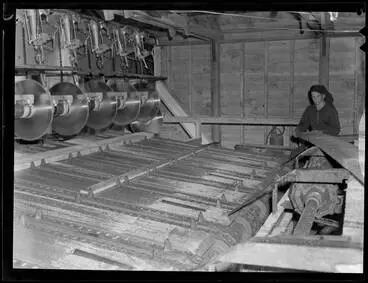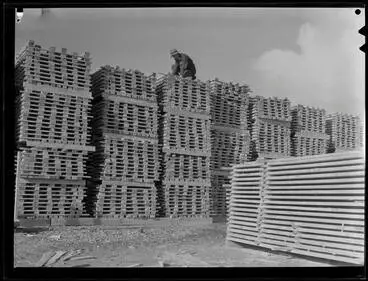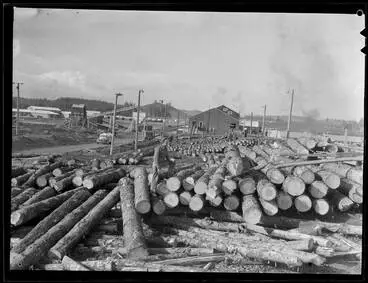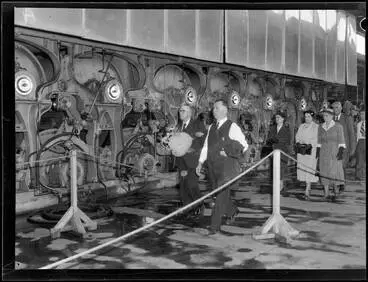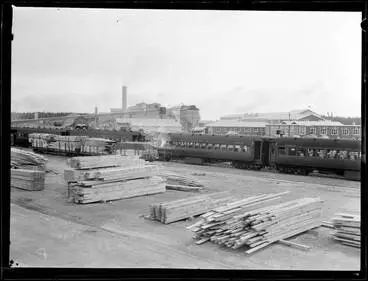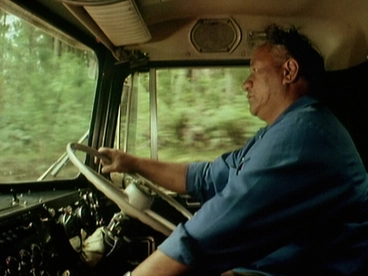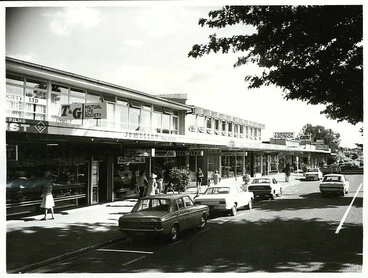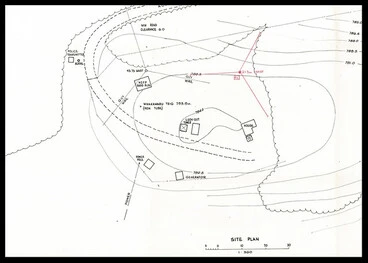Tokoroa - Our timber town stories
A DigitalNZ Story by Zokoroa
A pictorial journey through Tokoroa's earliest beginnings from its growth as a farming community and timber town, to it nearly becoming a city, together with stories from 'locals'.
Tokoroa, South Waikato, Waikato, Timber, Farming, Kinleith, Housing, Schools, Moa, Woodchopping. Kinleith Mill
Tokoroa lies at the heart of the North Island's South Waikato district. When you think of 'Tokoroa' what springs to mind? - Timber town? The sulphurous smell of Kinleith Mill? NZ Forest Product houses? Wood chopping at the annual A.&P. Show? Pasifika / Māori / European community? Local RSA cricket picnics? TT2 ice blocks and jelly tips at the dairy? Pie cart munchies? Those are some of my memories from my childhood days and teen years growing up in Tokoroa. Here's a pictorial journey of Tokoroa's earliest beginnings from its growth as a farming community and timber town, to it nearly becoming a city - yes, nearly a city!
Heart of the South Waikato
Manatū Taonga, the Ministry for Culture and Heritage
TELL US - LOCAL STORIES
What memories do you have of Tokoroa? Were you born there? Grew up or worked there? Or travelled by on the State Highway and had a rest stop? Here are some recollections shared by 'locals'....
Tokoroa, timber town - Roadside Stories
Manatū Taonga, the Ministry for Culture and Heritage
Saving Love Soup Tokoroa - Julie King
Radio New Zealand
Cook Islands women in Tokoroa celebrated in new book
Radio New Zealand
THE TALKING POLES
Positioned around the town are 'talking poles' which depict the diversity of cultures in the Tokoroa community. Several poles are made from pine and other local woods, to reflect Tokoroa's forestry heritage. See the Talking Poles Index for a description of the many poles on display, which will eventually number 60, and the story each pole tells.
Raukawa 'talking pole': The ancestor of Ngāti Raukawa
Manatū Taonga, the Ministry for Culture and Heritage
Pacific memories 'talking pole'
Manatū Taonga, the Ministry for Culture and Heritage
QUIRKY TALES
Hands up who remembers Tokoroa's legendary pie cart in Leith Place near SH 1 and it didn't sell pies! (See article). How's this for ingenuity - chess players miles apart in Tokoroa and Gisborne relaying their moves via the Amateur Radio Transmitters Club! Did you hear the tale about wild dogs on the loose in the early days?
Pie Cart
The 'Tokoroa special' = chips, grated cheese and mayo. (And pies weren't on the menu!)
Manatū Taonga, the Ministry for Culture and Heritage
Chess by radio
Tokoroa and Gisborne Chess Clubs battle it out! (1962 photo)
Gisborne Photo News
FASCINATING FACTS: MOA, ROCK ART & CARVINGS
Tokoroa is one of a very few known inland North Island moa hunter sites. Yes, moa! Excavations on farmland near the Matarawa Stream have uncovered moa bones, early adzes, and obsidian flakes. (See: An inland archaic site and Tokoroa moa-hunter site.) The Council and Pūtake Taiao are involved with the ongoing management of this historic reserve, known as Te Tokotokoroa a Matarawa, which lies to the west of James Higgins Park. Rock art with ochre markings and carvings (including a canoe) have also been discovered in small shelters in ignimbrite cliffs near Tokoroa, along with a number of objects - waka huia lid, obsidian flakes, chert flake, adze, bird bone toggle, wooden comb top and a stone pounder. (See Archaeology in the Bay of Plenty.)
The small ‘bush’ moa, Euryapteryx Curtis, has been found in Tokoroa
Manatū Taonga, the Ministry for Culture and Heritage
Moa bones found near Matarawa Stream on west side of Tokoroa houses
Alexander Turnbull Library
Rock art and carvings also found near Tokoroa
Manatū Taonga, the Ministry for Culture and Heritage
MUSICAL / ARTISTIC JOURNEYS
Did you watch music shows like "The Grunt Machine" and "Radio with Pictures" on the TV? And did you enjoy Tokoroa's pub scene with groups like soul funk band Shriek Machine who appeared on NZ telly and later renamed themselves Collision (See article)? Kiwi music legend Jenny Morris was born in Tokoroa and inducted into the New Zealand Music Hall of Fame at the 2018 APRA Silver Scroll Awards (See article). What other musicians and artists came from Tokoroa? Let's see: Stella Duffy and .......
Soul funk legends - Collision - started out as the Shriek Machine in 1969 & came 3rd in 'Battle of the Bands' final
The band moved to Wellington in 1972; then Sydney in 1977; and toured with Dalvanius, Tina Turner, Commodores and others
Radio New Zealand
Singer Jenny Morris
Sang with Wide Mouthed Frogs, The Crocodiles, QED, INXS (backing vocals) & went solo. (Love 'Body and Soul' LP)
NZ On Screen
Author Stella Duffy
Author and theatre director
Radio New Zealand
MULTICULTURAL STORIES
Tokoroa's diverse community was celebrated with a variety of festivals, including the Māori Cultural Festival, the Polynesian Festival and the Tokoroa A.&.P. Show Festival.
Māori Culture:
The southern Waikato and northern Taupō are the ancestral home of Ngāti Raukawa. (See Te Ara's Story: Ngāti Raukawa). Tokoroa has two marae: "Ngātira Marae and Te Tikanga a Tāwhiao meeting house which are associated with the Ngāti Raukawa hapū of Ngāti Ahuru and the Waikato Tainui hapū of Ngāti Korokī and Ngāti Raukawa ki Panehākua. Ōngāroto Marae and Whaita meeting house are affiliated with the Ngāti Raukawa hapū of Ngāti Whaita". (Source: Wikipedia: Tokoroa)
Ngātira Marae and Te Tikanga a Tāwhiao meeting house
Alexander Turnbull Library
Maori meeting house Te Tikanga a Tawhiao at Ngatira Pa, Ngatira
Alexander Turnbull Library
Closeup view of the doorway of Te Tikanga a Tawhiao meeting house at Ngatira, South Waikato
Alexander Turnbull Library
Ōngāroto Marae and Whaita meeting house
Manatū Taonga, the Ministry for Culture and Heritage
Papa o Te Aroha Marae, Tokoroa
The Marae was established by the Tokoroa Catholic Māori Society as a community marae in 1987
NZEI Te Riu Roa (New Zealand Educational Institute)
Hui ā Tau 1995
NZEI Te Riu Roa (New Zealand Educational Institute)
Hui ā Tau 1995
NZEI Te Riu Roa (New Zealand Educational Institute)
I recall students at our Tokoroa East School being part of the Kapa Haka group. At Tokoroa Intermediate, students learnt tāniko weaving and piupiu making, which they gave displays of during the Tokoroa Māori Festival held at the Tokoroa New Memorial Hall. Nowadays, the Tokoroa Polynesian Festival with Māori, Samoan, and Cook Islands performances, is held in September at the new South Waikato Sport and Events Centre, located at the Tokoroa Memorial Sports Ground.
Tokoroa Maori Culture Festival - (Te Ao Hou - No. 57 December 1966)
Alexander Turnbull Library
Pacific Cultures:
Large numbers of Pacific Island people, including from the Cook Islands, Samoa, Fiji, Tonga and Niue, emigrated to work at the Kinleith Mill. On Sundays, you would see beautifully dressed women wearing colourful flowers in their hair outside the St Luke's Pacific Islanders Presbyterian Church on Maraetai Road.
1958: Pacific Islanders Church opens
Alexander Turnbull Library
Polynesian festival, 2004
Manatū Taonga, the Ministry for Culture and Heritage
Stories of how the Tokoroa Cook Island Community preserve their culture through "Uapou' or 'fellowship'
The Coconet TV
European Cultures:
Workers attracted to Tokoroa included assisted immigrants from the United Kingdom and the Netherlands. The expectation that Tokoroa would become NZ's next city was an added drawcard for others living elsewhere in New Zealand during the late 1950s - 70s. Family traditions were reflected in the forms of entertainment, which included Scottish dancing and balls. The annual social highlight was the Tokoroa A.&P. Show - you could 'show' animals, enjoy amusement park games, eat pink candyfloss, and watch the 'must-see' event - the woodchopping and sawing competitions!
Video of A.&P. Showgrounds (1964)
Archives New Zealand Te Rua Mahara o te Kāwanatanga
Woodchopping events
If you were born or lived in Tokoroa for a number of years, it has been said you have woodchopping in the blood and can 'smell' the sawdust for an event miles away! The Tokoroa A.&P. Show's woodchopping was a popular event where family, friends and interested onlookers cheered on the competitors. The two-day Tokoroa Golden Axe Festival is the premier woodchopping competition with open and championship events that draw competitors nationwide and internationally. You can view 'action' videos on Youtube.
Muscle men at the Games: Bruce Alexander (Tokoroa) on 11" standing jigger chop
Tauranga City Libraries
WEEKEND LEISURE
Leisure hour activities have varied over the decades. In the sixties, for example, you could go to the movies, public library, roller skating rink, swimming baths, or pursue club or sporting interests. Pocket money treats included TT2 iceblock, jelly tip, topsy, and pineapple lumps. Children in our neighbourhood socialised by playing skipping, hopscotch and marble games; enjoying tennis on the road; making kites; and racing home-built trolleys down the nearby hilly road. We also swam in the Matarawa Stream and a dam was built in 1975 to create Lake Moananui. Our street (Elizabeth Drive) also started up a library in a small shed in the mid-sixties where we could swap our children's books.
Going to the movies & eating Tip Top ice cream and pineapple lumps
The former cinema on Mannering Street is now the site of the Tokoroa Public Library
NZ On Screen
Playing marbles, hopscotch & skipping
Marbles was our neighbourhood sport of champions!
DigitalNZ
Joining activities at the Tokoroa Youth Centre which opened in 1964
Tauranga City Libraries
Picnicking, boating & swimming on man-made Lake Moananui
Created when dam placed across Matarawa Stream (1975)
iNaturalist NZ — Mātaki Taiao
Social watering holes, CLUB & VOLUNTEER CULTURE
The community spirit in Tokoroa was evident with the number of clubs and volunteer organisations.
The RSA organised commemorative Anzac ceremonies and activities, like the family cricket picnics held in Tokoroa and at Hamilton's Lake Rotoroa. Tokoroa also has two civic war memorials: the Tokoroa Memorial Sportsground, which was opened in 1953, and the memorial wall outside the South Waikato District Council offices.
Social watering holes included the Tokoroa Club and Cosmopolitan, in addition to the Tokoroa Hotel, the Timberlands and the Trees Tavern. Young people could join groups like the Red Cross, St. John's and the Scouts/Guides. Community projects were supported through organisations like the Jaycees and Lions Club. Volunteers also helped the St. John Ambulance Service and the Tokoroa Volunteer Fire Brigade - the town siren would sound the alarm and you'd see workers sprinting to the fire engine. And the list goes on....
Tokoroa War Memorial wall outside the South Waikato District Council offices
On 17 Oct 1953 Major General Sir Howard Kippenberger opened Tokoroa Memorial Sportsground for those who served in WWII
Manatū Taonga, the Ministry for Culture and Heritage
Tokoroa Drama Club
Massey University
SPORTING EXPLOITS
The Tokoroa Memorial Sportsground was the place to be for sporting and social activities that brought the community together, and is now home to the South Waikato Sport and Events Centre. Sporting memories include frosty Saturday mornings playing netball and spending summery days at the Athletics Club and the town swimming baths. The Tokoroa East Bowling Club, which was located by the netball courts, flourished in local and regional competitions, until it closed due to falling numbers. The Tokoroa Bowling Club is still operating since the first roll up on its greens in 1951. Locals also headed along the road to the golf course or out into the bush country for off-road biking, pig hunting and eeling. You could tell when Kinleith workers were on strike by the number of vehicles parked on the side of the highway - pighunters and their dogs were busy in the forests!
Tokoroa Memorial Sportsground opened 1953
Multi-purpose sports oval, bowling greens, croquet lawns, combined netball & tennis courts, and sports pavilions
Manatū Taonga, the Ministry for Culture and Heritage
Sporting stars:
Over the years various sports 'stars' have had their turn in the spotlight in NZ and overseas. For example, see article on rugby players which includes being in the All Blacks (naturally!) and the list of notable sportspeople on Wikipedia. Also see list of champion lawn bowlers on Tokoroa Bowling Club's website.
Athletics - John Davies MBE
1962 Perth British Empire Games & Commonwealth Games: 1 mile (Silver); 1964 Tokyo Olympics: 1500m (Bronze). MBE 1990.
Te Toi Uku, Crown Lynn and Clayworks Museum
All Blacks - Walter Little
50 tests: 1990 - 1998
Alexander Turnbull Library
Silver Ferns - Maria (Tuta'ia) Folau
2005 - 2019
Manatū Taonga, the Ministry for Culture and Heritage
Lawn bowls - Marina Khan
2006 Commonwealth Games: bronze medal
Manatū Taonga, the Ministry for Culture and Heritage
Tall Blacks - Pero Cameron
Captain from 2000 - 2010. Received New Zealand Order of Merit for basketball (2011)
Manatū Taonga, the Ministry for Culture and Heritage
Hall of Fame (2017)
Pero Cameron was inducted into FIBA Hall of Fame 2017
Radio New Zealand
STORY OF TOKOROA'S BEGINNINGS
The origin of the town's name is possibly taken from the nearby 'Tokoroa Plains' which appear on 19th-century maps. The surveyor may have commemorated Tokoroa, a chief of the Ngāti Kahupungapunga, who was killed by the invading Ngāti Raukawa during the 1600s. (See Te Ara and the Journal of the Polynesian Society.) During the Government's negotiations for land in the Patetere District of the Waikato, parts of the Tokoroa Block were subdivided off (1881). 'For sale' advertisements were placed in N.Z. and England to attract settler farmers.
Districts of Ngāti Raukawa in southern Waikato
Manatū Taonga, the Ministry for Culture and Heritage
Tokoroa Block Land Deed, 1877
Victoria University of Wellington
London advert for farmers (1884)
Parts of the Tokoroa Block were subdivided in 1881
National Library of New Zealand
Farmland
Alexander Turnbull Library
FARMING SETTLEMENT
A small farming settlement began with sheep and dairy cattle during the early 1900s. Initially the land surrounding Tokoroa was owned by the Thames Valley Land Company and then the Matarawa Land Company from 1914. Land sales were slow due to the quality of the pumice soils causing 'bush sickness' in animals. After the soil's cobalt deficiencies were addressed in the 1930s, the farming of stock became more profitable.
Aerial view of farmland forestry and housing
Alexander Turnbull Library
1913: Settlers farming land
National Library of New Zealand
1919: Cheese factory opens
Auckland Libraries
Farming on pumice lands (1921)
National Library of New Zealand
Matarawa Land Company advertisement (1923)
National Library of New Zealand
Stock farming flourishing (1944)
Auckland Libraries
FORESTRY INDUSTRY: EXOTIC TIMBERS
The Taupo Totara Timber Company (TTT) was set up in Putaruru in 1901 by a group of Wellingtom businessmen, to harvest stands of totara and matai south of Tokoroa. A sawmill (the district's first) was established in 1903 at Kopokorahi, near Kinleith. In the 1970s, TTT was taken over by NZ Forest Products, which eventually became part of Carter Holt Harvey.
A private bush railway line was built from Putaruru to Mokai which started transporting logs in 1905. Three years later goods and passengers were carried. With the cutting out of the bush at Mokai, dismantling the line was commenced in 1944. The Ministry of Works constructed a much heavier line on the site of the light railway to serve the Kinleith mills in 1948.
FORESTRY INDUSTRY: PINUS RADIATA
With the pumice soil suitable for forestry, pine forests were planted from 1925 by New Zealand Perpetual Forests which evolved into New Zealand Forest Products (NZFP). The next lot of planting was carried out NZFP in 1935. When these trees matured in the 1940s, a sawmill and a pulp and paper mill were set up at Kinleith.
1951
Alexander Turnbull Library
KINLEITH MILL: 1954 -
The Kinleith Mill was built by NZFP eight kilometres south of the Tokoroa township. It is located alongside the Putaruru-Taupo Highway and the Government-owned railway line which was extended from Putaruru to Kinleith in 1952. In 1954 the works began producing timber, pulp, and paper. The Mill is named after the Kinleith paper mills near Edinburgh in Scotland, where NZFP founder director Sir David Henry served his papermaking apprenticeship.
Kinleith Mill built south of Tokoroa, opened 1954
Auckland Libraries
Kinleith Pulp and Paper Mill official opening, 1954
Auckland Libraries
National Film Unit video of papermaking process (1954)
Manatū Taonga, the Ministry for Culture and Heritage
Kinleith New Zealand Forest Products Ltd, [Tokoroa?]
Alexander Turnbull Library
New Zealand Forest Products Ltd, Kinleith, South Waikato
Alexander Turnbull Library
Kinleith strike poster, 1980
Manatū Taonga, the Ministry for Culture and Heritage
Cable logging of radiata pine
Manatū Taonga, the Ministry for Culture and Heritage
Film about timber work at Tokoroa and Kawerau
from planting to felling to finished product (1984)
NZ On Screen
Carter Holt Harvey bought the New Zealand Forest Products forests in 1991. As the plantations were cut down, former forestry land was converted into dairy farms. American International Paper purchased shares in Carter Holt Harvey and by 1995 had a 50.5% controlling interest. In 2005 Rank Group Investments Ltd, controlled by Graham Hart, purchased American International Papers holding and Carter Holt Harvey became wholly owned by Rank Group Investments. With the fall in demand from export markets in Australia and a decline in new building projects in NZ, the dairy farms were sold and the workforce numbers at Kinleith declined through redundancies.
In 2014 the Kinleith, Tasman and Penrose paper mills were sold to Japanese company Oji Fibre Solutions. Kinleith produces over 600,000 tonnes per annum of packaging papers and bleached softwood kraft market pulp. Most of the pulp is exported to markets in Asia for use in the manufacture of printing and writing paper, boards and tissue.
2014
Kinleith owned by Japanese pulp and paper maker, Oji Fibre Solutions
Radio New Zealand
TOWNSHIP DEVELOPMENT
Local politics: From town > Borough > district council:
Tokoroa was constituted a county town on 1 April 1953 and it became a county borough with its own mayor under the Tokoroa Town Empowering Act 1965. Later the Tokoroa Borough Council was established in 1975. Since 1989, Tokoroa has been part of the Waikato District Council which was established through the merger of the Tokoroa Borough Council and the Putaruru Borough Council (established in 1926). The South Waikato District Council encompasses four main towns - Tokoroa, Putāruru, Tīrau and Arapuni. The main office is in Tokoroa, with a second office in Putāruru.
Population:
Spot the changes in the township as the population grew! Back in 1948 Tokoroa had 242 people. Population Census figures for the 1950s show the rate of increase: 1951 census = 1,193; 1956 census = 5,366; 1961 census = 7,054. With the growth of Kinleith Mill, Tokoroa was expected to become a city of 20,000 people. Instead, the population peaked in 1981 at 18,713 people and, thereafter, continued to fall as Kinleith reduced its operations. Since 1989, a town has needed 50,000 people to become a city. The 2018 New Zealand Census recorded a population of 13,578, of which ethnicities were: 59.0% European/Pākehā, 42.7% Māori, 20.7% Pacific peoples, 4.2% Asian, and 1.4% other ethnicities. (Note: totals add to more than 100% since people could identify with multiple ethnicities.)
Housing Subdivisions:
To house its growing workforce, NZ Forest Products built 2,230 workers’ houses between 1947 - 1976, as well as camps for single men. From the 1960s, land was subdivided by private industry and the Matamata County Council. As subdivisions were opened up for owner-built homes, the Matarawa Stream formed the western boundary for the township.
1953:
Township planning spanning the Putaruru-Kinleith railway line
Alexander Turnbull Library
1953:
Streets being laid out for housing Kinleith workers
Manatū Taonga, the Ministry for Culture and Heritage
1958: Northern entrance
Township with Kinleith to the south, and farmland surroundings
Alexander Turnbull Library
1976: Tokoroa Hospital in foreground
Looking northward with the Lake Moananui and Matarawa Stream on western boundary
Alexander Turnbull Library
1976: Owner-built homes
Looking southward along Elizabeth Drive, with Matarawa Stream as western boundary
Alexander Turnbull Library
1981: Tokoroa's population peaked at 18,713 people
To be classified as a city, a population of 20,000 was required. (Since 1989, a population of 50,000 is required.)
National Library of New Zealand
Shopping Centre:
Over the years there has been a range of stores, including Woolworths and, more recently, the Warehouse. In the 1960s, Friday night treats in front of cartoons on the TV were fish, battered sausages and chips. The local takeaway welcomed copies of the South Waikato News and NZ Herald newspapers to recycle as wrapping. The dining out treat was at the Chinese restaurant in town. The choices for dining experiences have since increased, including the fast food outlets that can be seen today.
Shops at Leith Place (1976)
Archives New Zealand Te Rua Mahara o te Kāwanatanga
Arrival of other businesses:
Egmont Box Company (1956)
The factory was built on 18 acres and began manufacturing cheese crates in 1946
Alexander Turnbull Library
Egmont Box Company was sold to NZ Forest Products Ltd in 1966
Massey University
Plan of Tokoroa Mobile Telephone Control Station (1975)
Archives New Zealand Te Rua Mahara o te Kāwanatanga
Clubs & pokie machines controversy made national news (2018)
Radio New Zealand
SCHOOLING
The local schools were a social hub of the community drawing families together. The first school built was Tokoroa School (later renamed Tokoroa East) which opened in 1915 with a roll of 9 students and closed on 1 April 2010. (See The story of Tokoroa East School.) In 1954 the second school opened and was named Tokoroa Central School. Tokoroa High was officially opened in October 1957, Amisfield School in 1956, and Matarawa School in 1958 (and later closed in 1999). With further increases in the population, Tokoroa South School (now named Strathmore School) opened in 1965. As Tokoroa's population increased, new schools were built (see Wikipedia article) and tertiary education options were provided.
Tokoroa East School opened 1915
Tokoroa School (later renamed Tokoroa East) closed on 1 April 2010 (Photo 1958)
Alexander Turnbull Library
View of Tokoroa East School (bottom left ) looking towards the shops at middle right (1958)
Alexander Turnbull Library
Tokoroa East School (1959)
Aerial view of location next to Showgrounds on left side of SH 1
Alexander Turnbull Library
Closure notice for Tokoroa East: 1 April 2010
Department of Internal Affairs
Tokoroa High School opened 1957
Tokoroa High School was opened officially on 19 October 1957. (Photo 1958)
Alexander Turnbull Library
Tokoroa High & Matarawa School (opened 1958 & closed in 1999)
Aerial photo 1959
Alexander Turnbull Library
Regional Waiariki campus opened in 1978
Manatū Taonga, the Ministry for Culture and Heritage
Secondary students interviewing Helen Clark on the campaign trail (2008)
Radio New Zealand
Travel to University subsidised (2015)
Radio New Zealand
Happenings since 2020:
How is Tokoroa doing?
Radio New Zealand
How Covid-19 is impacting Tokoroa
Radio New Zealand
Singapore-based OFI announce (2021) will build a dairy processing plant
Radio New Zealand
For recipients of the Queen's Birthday Honours and New Year Honours, see the NZ Gazette which lists online recipients from 1993 onwards.
Queen's Birthday Honours 2021
MNZM awarded to Mrs Heather Margaret Williamson, JP, of Tokoroa. For services to netball and the community.
Department of Internal Affairs
At 2022 Keep NZ Beautiful Awards, Tokoroa won best loos!
Radio New Zealand
(This DigitalNZ story was created in 2018 and updated in May 2024)


